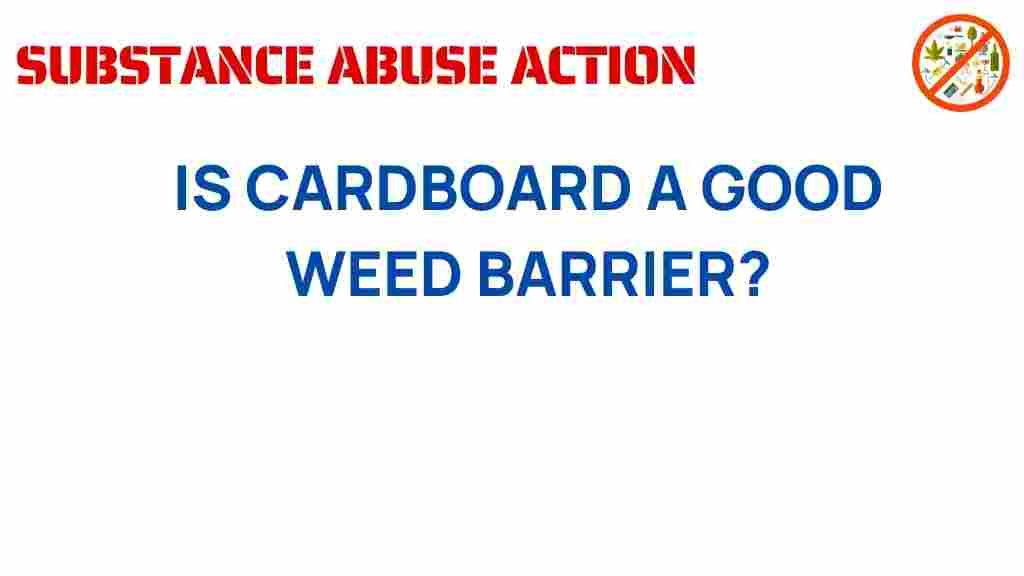Unveiling the Truth: Is Cardboard a Reliable Weed Barrier?
In the world of gardening and landscaping, the quest for effective weed control is a common challenge. Many gardeners are turning to cardboard as a potential weed barrier, intrigued by its sustainability and environmental benefits. But is cardboard truly a reliable solution for weed management? In this article, we will explore the effectiveness of cardboard as a weed barrier, its impact on soil health, and its role in sustainable gardening practices.
What is Cardboard and How Does it Work as a Weed Barrier?
Cardboard is a biodegradable material made from recycled paper products. When used as a weed barrier, it functions by blocking sunlight, which prevents weed seeds from germinating. Additionally, as cardboard breaks down, it enriches the soil with organic matter, promoting healthy soil biology.
The Environmental Impact of Using Cardboard
Using cardboard as a weed barrier aligns with eco-friendly solutions in gardening and landscaping. Here are some environmental benefits:
- Recycling: Cardboard is often made from recycled materials, reducing waste.
- Biodegradable: Unlike plastic barriers, cardboard decomposes naturally, enhancing soil health.
- Soil Health: As it breaks down, cardboard adds nutrients to the soil, benefiting your plants.
How to Use Cardboard as a Weed Barrier: A Step-by-Step Guide
Implementing cardboard in your garden as a weed barrier is simple and requires minimal materials. Follow these steps for effective application:
Step 1: Gather Your Materials
You will need:
- Cardboard (preferably non-glossy and free from tape or labels)
- Scissors or a box cutter
- Water
- Mulch (optional)
Step 2: Prepare the Area
Clear the area where you plan to lay the cardboard. Remove any existing weeds, debris, or rocks. This will ensure that the cardboard lays flat and effectively blocks sunlight.
Step 3: Cut Cardboard to Size
Using scissors or a box cutter, cut the cardboard into pieces that fit your garden layout. Make sure to overlap the edges to prevent weeds from sneaking through.
Step 4: Moisten the Cardboard
Before laying the cardboard down, soak it with water. This helps it to conform to the ground and makes it less likely to blow away.
Step 5: Lay the Cardboard
Place the moistened cardboard directly on the prepared soil. Ensure that there are no gaps where sunlight can penetrate. You can add a layer of mulch on top for added protection and aesthetics.
Step 6: Monitor and Maintain
Regularly check the cardboard layer to ensure it is still in place and effective. Over time, it will break down and may need to be replaced or added to.
Troubleshooting Common Issues with Cardboard Weed Barriers
While cardboard can be an excellent weed barrier, some issues may arise. Here are common problems and their solutions:
- Cardboard Blowing Away: If winds are strong, weigh down the edges with stones or soil.
- Decomposition Too Fast: In highly organic soils, cardboard may decompose quickly. Consider layering more cardboard or adding mulch to slow down the process.
- Weeds Still Coming Through: Ensure that the cardboard is thick enough and laid without gaps. If necessary, add a second layer.
The Impact of Cardboard on Soil Health
One of the key advantages of using cardboard as a weed barrier is its positive impact on soil health. As cardboard decomposes, it:
- Increases soil organic matter, improving nutrient retention.
- Encourages beneficial microorganisms that enhance plant growth.
- Helps retain moisture, reducing the need for frequent watering.
Comparing Cardboard with Other Weed Barriers
When considering weed barriers, it’s important to weigh the pros and cons of cardboard against other common materials:
| Material | Benefits | Drawbacks |
|---|---|---|
| Cardboard | Biodegradable, improves soil health, cost-effective | May need replacement, can blow away |
| Plastic | Durable, effective at blocking weeds | Not biodegradable, harms soil health |
| Landscape Fabric | Long-lasting, effective | Can be expensive, may restrict water and nutrients |
Overall, while cardboard may not last as long as plastic or landscape fabric, its environmental benefits and contribution to soil health make it a compelling choice for many gardeners.
Integrating Cardboard into Sustainable Gardening Practices
Using cardboard as a weed barrier fits seamlessly into sustainable gardening practices. Here are some ways to integrate cardboard into your garden:
- Composting: After its useful life as a barrier, cardboard can be added to your compost pile.
- Sheet Mulching: Combine cardboard with layers of organic materials to create a rich, weed-free bed.
- Water Conservation: Use cardboard to reduce evaporation and maintain soil moisture.
Conclusion
In conclusion, cardboard can be a highly effective and reliable weed barrier when used correctly. Its benefits extend beyond simple weed control, positively impacting soil health and supporting sustainable gardening practices. By choosing cardboard, gardeners can embrace eco-friendly solutions that align with their environmental values.
As the gardening community continues to explore sustainable methods, cardboard stands out as a practical option that enriches the soil while effectively managing weeds. Whether you’re an experienced gardener or just starting out, consider giving cardboard a try in your next landscaping project.
For more information on sustainable gardening practices, visit this resource. If you’re interested in exploring other gardening techniques, check out our article on eco-friendly solutions.
This article is in the category Health and created by SubstanceAbuseAction Team
